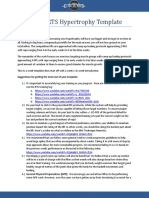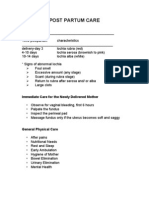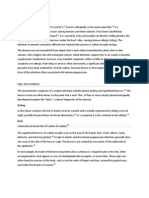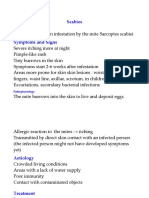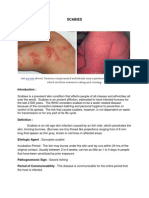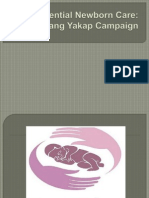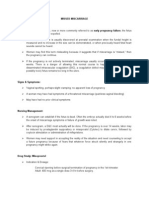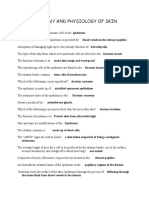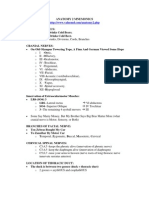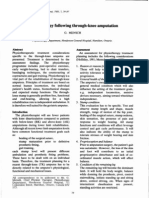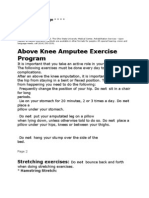Post Natal Exercise Prescription
Post Natal Exercise Prescription
Uploaded by
Senthilkumar ThiyagarajanCopyright:
Available Formats
Post Natal Exercise Prescription
Post Natal Exercise Prescription
Uploaded by
Senthilkumar ThiyagarajanOriginal Description:
Copyright
Available Formats
Share this document
Did you find this document useful?
Is this content inappropriate?
Copyright:
Available Formats
Post Natal Exercise Prescription
Post Natal Exercise Prescription
Uploaded by
Senthilkumar ThiyagarajanCopyright:
Available Formats
7031 version 3
16-Oct-03
1 of 8
EXERCISE PRESCRIPTION
Apply knowledge of exercise
prescription to ante- and post-natal
women
level: 5
credit: 4
final date for comment: December 2002
expiry date: December 2003
sub-field: Fitness
purpose: People credited with this unit standard are able to: apply
exercise considerations and guidelines to exercise
prescription for women during pregnancy and following
childbirth; adapt fitness assessment protocols for ante- and
post-natal women; establish cooperative relationships with
medical and maternity professionals; choose exercises and
exercise modes for safe development and maintenance of
fitness in pregnancy and restoration of fitness following
childbirth; and design programmes to satisfy safety guidelines
and client’s fitness goals. This unit standard is designed for
people specialising in providing exercise prescription services
to individual women and to groups working with ante- and
post-natal women.
entry information: Prerequisites: Unit 7021, Demonstrate exercise techniques;
and Unit 7022, Demonstrate knowledge of the principles of
safe physical activity; or demonstrate equivalent knowledge
and skills.
accreditation option: Evaluation of documentation and visit by NZQA and industry.
moderation option: A centrally established and directed national moderation
system has been set up by the Sport, Fitness and Recreation
Industry Training Organisation - Fitness Advisory Group.
New Zealand Qualifications Authority 2003
7031 version 3
16-Oct-03
2 of 8
EXERCISE PRESCRIPTION
Apply knowledge of exercise
prescription to ante- and post-natal
women
special notes: 1 In this context, the concept of client must be considered
to include the present and future safety and health of the
unborn child or children involved.
2 Fitness sector unit standards use the term facility to
refer to the workplace which may be a fitness centre, a
recreation centre, an aquatic centre, or a community
centre where fitness activities take place. Where
usage is unclear it may help to consider facility
standards as being equivalent to employer standards.
3 Competence in this unit standard requires knowledge of
guidelines from the American College of Obstetricians
and Gynaecologists (ACOG) lists of contraindications for
exercise and indications for halting an exercise session
as published in Exercise during Pregnancy and
Postpartum Period (ACOG) Home Exercise Programs.
Washington DC. ACOG, 1994 (ACOG technical bulletin,
no 189).
New Zealand Qualifications Authority 2003
7031 version 3
16-Oct-03
3 of 8
EXERCISE PRESCRIPTION
Apply knowledge of exercise
prescription to ante- and post-natal
women
Elements and Performance Criteria
element 1
Apply exercise considerations and guidelines to exercise prescription for women during
pregnancy and following childbirth.
performance criteria
1.1 Exercise considerations and guidelines for ante- and post-natal women are
described in terms of effects of exercise on mother.
Range: as per each trimester and the post-natal period
physiological effects (per trimester) to include - heart rate (rest
and exercise), arrhythmia, blood pressure changes, respiratory
changes, oedema (nerve compression syndromes);
biomechanical effects (per trimester and post-natally) to include -
centre of mass, joint laxity (musculoskeletal injuries), postural
hypotension;
nutritional effects include - changes in energy needs, nutrient
needs and hydration needs, consequences of inadequate diet;
psychological effects include - reaction to performance
decrements, weight gain, changing attitudes of others.
New Zealand Qualifications Authority 2003
7031 version 3
16-Oct-03
4 of 8
EXERCISE PRESCRIPTION
Apply knowledge of exercise
prescription to ante- and post-natal
women
1.2 Exercise considerations and guidelines for ante- and post-natal women are
described with reference to effects of maternal exercise on the foetus and foetal
development.
Range: as per each trimester
foetal temperature (congenital malformation), competition for blood
flow, oxygen delivery, and glucose availability, effects of exercise
hormonal levels, foetal distress, intrauterine growth retardation,
physical constriction.
1.3 Analysis of exercise session and programme management for ante- and post-
natal women describes indicators for consultation with health professionals
involved with clients, and for ceasing or modifying exercise and programming.
Range: medical history, target heart rates, target durations, physiological
indicators, perceived level of exertion, acute physical symptoms,
mood states, post-exercise symptoms, gradual onset symptoms;
health professionals - doctor, midwife.
New Zealand Qualifications Authority 2003
7031 version 3
16-Oct-03
5 of 8
EXERCISE PRESCRIPTION
Apply knowledge of exercise
prescription to ante- and post-natal
women
element 2
Adapt fitness assessment protocols for ante- and post-natal women.
Range: protocols may include but are not limited to
fitness assessment protocol categories - screening and body dimension
assessments, flexibility assessments, sub-maximal aerobic capacity
assessments;
screening and body dimension assessment protocols include - blood pressure at
rest and in exercise, tape measurements, body mass index, somatotyping;
flexibility assessment protocols include - Sit and Reach Test, Sahrman Tests for
hamstring length, hip flexor length, and quadriceps (rectus femoris) length, Apley
Scratch Test;
sub-maximal aerobic capacity assessment protocols include - Åstrand-Ryhming
Step Test, Canadian Home Fitness Test, Åstrand-Ryhming Cycle Ergometer
Test, Rockport 1 Mile Walk Test.
performance criteria
2.1 Identify fitness assessment protocols which, without adaptation, are outside
safety guidelines for ante- and post-natal women (ACOG Guidelines).
2.2 Prepare in written form an adaptation of a fitness assessment protocol from each
category to meet safety guidelines for ante- and post-natal women.
2.3 Demonstrate an adapted fitness assessment protocol from each category to
meet facility standards.
New Zealand Qualifications Authority 2003
7031 version 3
16-Oct-03
6 of 8
EXERCISE PRESCRIPTION
Apply knowledge of exercise
prescription to ante- and post-natal
women
2.4 Comparison of physical responses of women to standard exercise tests
establishes group differences between ante-natal, post-natal, and non-pregnant
women.
Range: body weight, girth measures, flexibility measures, heart rate
response to aerobic work.
element 3
Establish cooperative relationships with medical and maternity professionals.
Range: general practitioners, midwives, Independent Midwifery Service.
performance criteria
3.1 Knowledge of local resources is demonstrated by listing local individuals and
organisations providing professional and volunteer services to pregnant and post-
natal women.
3.2 Documentation is provided to enable clients to give informed consent permitting
specified information sharing with other medical and maternity professionals with
whom the client is involved.
3.3 Knowledge of medical terminology - including abbreviations - related to
pregnancy and childbirth is demonstrated through interpretation of technical
information from medical and maternity professionals.
3.4 Communication is established with other health professionals in relation to
individual clients in order to facilitate exercise prescription for those clients.
Range: communication includes - goals of programming, qualifications of
fitness personnel, facilities and programmes available at centre,
emergency medical back up available to centre clients.
New Zealand Qualifications Authority 2003
7031 version 3
16-Oct-03
7 of 8
EXERCISE PRESCRIPTION
Apply knowledge of exercise
prescription to ante- and post-natal
women
element 4
Choose exercises and exercise modes for safe development and maintenance of fitness in
pregnancy and restoration of fitness following childbirth.
Range: clients’ needs - maintenance of fitness in pregnancy, physical conditioning for
childbirth, restoration of fitness following childbirth.
performance criteria
4.1 Selection of exercises and exercise modes matches clients’ needs and goals
within ACOG safety guidelines.
Range: type of exercise, intensity, body position, fitness component,
availability, accessibility, cost.
4.2 Consultation with client establishes acceptability of and commitment to exercises
and exercise modes chosen by instructor.
4.3 Discussion of safety guidelines with client meets client’s needs for understanding
of exercise and programme restrictions and guidelines.
element 5
Design programmes to satisfy safety guidelines and client’s fitness goals.
performance criteria
5.1 Programme is designed to be consistent with safety guidelines (ACOG
guidelines) for exercise by ante- and post-natal women.
New Zealand Qualifications Authority 2003
7031 version 3
16-Oct-03
8 of 8
EXERCISE PRESCRIPTION
Apply knowledge of exercise
prescription to ante- and post-natal
women
5.2 Consultation with client’s medical and maternity advisers meets their needs for
information and client’s need for their support.
5.3 Consultation with client establishes client’s acceptance of programme targets and
timelines.
Comments to:
Sport, Fitness and Recreation Industry Training Organisation
- Fitness Advisory Group
Unit Standard Revision
PO Box 160
WELLINGTON
by December 2002.
Please Note: Providers must be accredited by the Qualifications Authority
before they can offer programmes of education and training
assessed against unit standards.
Accredited providers assessing against unit standards must
engage with the moderation system that applies to those unit
standards. [Please refer to relevant Plan ref: 0069]
New Zealand Qualifications Authority 2003
You might also like
- 7 Week 4x RTS Hypertophy Template PDFDocument6 pages7 Week 4x RTS Hypertophy Template PDFTomer Perkin80% (5)
- 1600+ WODS FormattedDocument494 pages1600+ WODS Formattedlarst06No ratings yet
- Outdoor AthleteDocument296 pagesOutdoor AthleteTina Dinh100% (2)
- PCC Cert PDFDocument17 pagesPCC Cert PDFGiancarlo Fernando GonzalezNo ratings yet
- Andrea Larosa 4 Weeks Calisthenics Training Program (Intermediate)Document32 pagesAndrea Larosa 4 Weeks Calisthenics Training Program (Intermediate)aqif mali100% (1)
- SC ppt19 3b Beatricedietz Report 1Document10 pagesSC ppt19 3b Beatricedietz Report 1api-642960909No ratings yet
- Virtual Lab Report by Honey Noreen Belnas: The Gram Stain: Identify and DifferentiateDocument16 pagesVirtual Lab Report by Honey Noreen Belnas: The Gram Stain: Identify and DifferentiateJihil Kisha0% (1)
- Institut Latihan Kementerian Kesihatan Malaysia Johor BahruDocument9 pagesInstitut Latihan Kementerian Kesihatan Malaysia Johor BahruFardzli MatjakirNo ratings yet
- Breast Feeding: OM Nursing Academy Anil Kantiwal GudhaDocument3 pagesBreast Feeding: OM Nursing Academy Anil Kantiwal GudhaBijay Kumar MahatoNo ratings yet
- Skin To SkinDocument9 pagesSkin To SkinAsiatiNo ratings yet
- Basic Brain Anatomy and Physiology PDFDocument10 pagesBasic Brain Anatomy and Physiology PDFSenthilkumar Thiyagarajan100% (3)
- Post Partum CareDocument3 pagesPost Partum Carer79cb5480No ratings yet
- ScabiesDocument16 pagesScabiescarla_sarmiento4847No ratings yet
- ScabiesDocument6 pagesScabiesReza MardanyNo ratings yet
- ScabiesDocument2 pagesScabiesyulia_azzahra5523No ratings yet
- Scabies CSDocument14 pagesScabies CSMochamadAriWibowo100% (1)
- BBI2424 SCL WORKSHEET 5 (WEEK 9) - UNITY & COHERENCEDocument4 pagesBBI2424 SCL WORKSHEET 5 (WEEK 9) - UNITY & COHERENCERon ChongNo ratings yet
- ScabiesDocument5 pagesScabiesKeilah MarieNo ratings yet
- Post Natal ExercisesDocument7 pagesPost Natal ExercisesEvie Dolpin BlueNo ratings yet
- ScabiesDocument7 pagesScabiessunilk09No ratings yet
- Paeds Case - Ketotic HypoglycaemiaDocument29 pagesPaeds Case - Ketotic HypoglycaemiaDuncan89No ratings yet
- ScabiesDocument8 pagesScabiesJessica Dumayas Dela RosaNo ratings yet
- ChapterDocument48 pagesChapterIzzati Zulaikha AmyNo ratings yet
- Ent300 Bussines OpportunityDocument14 pagesEnt300 Bussines OpportunityDanish DanielNo ratings yet
- Combined Oral Contraceptive PillDocument17 pagesCombined Oral Contraceptive PillnathanNo ratings yet
- 13.2 Aplikasi TopikalDocument42 pages13.2 Aplikasi TopikalSaha DirllahNo ratings yet
- B. Discharge Plan Areas Objective ActivitiesDocument3 pagesB. Discharge Plan Areas Objective ActivitiesNejie Zarrah DiazNo ratings yet
- ScabiesDocument2 pagesScabiesPRINTDESK by DanNo ratings yet
- Case Study Obstetric PatientDocument19 pagesCase Study Obstetric PatientPrinz Lozano100% (1)
- Hygiene and Sanitization in Food SectorDocument7 pagesHygiene and Sanitization in Food SectorscottNo ratings yet
- Premature Rupture of MembraneDocument7 pagesPremature Rupture of MembranedrommygreatNo ratings yet
- Antenatal CorticosteroidsDocument17 pagesAntenatal CorticosteroidsMahaLakshmiNo ratings yet
- Febrile Seizure Case FileDocument4 pagesFebrile Seizure Case Filehttps://medical-phd.blogspot.comNo ratings yet
- Essential Newborn CareDocument14 pagesEssential Newborn CareJhing Rodriguez BorjalNo ratings yet
- Missed MiscarriageDocument2 pagesMissed MiscarriageELyssa Anne Maristelle DizonNo ratings yet
- Atopic DermatitisDocument10 pagesAtopic DermatitisIboy ZulhamNo ratings yet
- Diarrhea: ChildrenDocument16 pagesDiarrhea: ChildrenEmmi Valentina PardedeNo ratings yet
- Nutrition For Infants, Children and Adolescents: Andrew Tershakovek, MDDocument40 pagesNutrition For Infants, Children and Adolescents: Andrew Tershakovek, MDdonira73No ratings yet
- Problems in Early PregnancyDocument11 pagesProblems in Early PregnancyRizal LeonardoNo ratings yet
- Pregnant Abdomen ExamDocument4 pagesPregnant Abdomen ExamAmiel Francisco ReyesNo ratings yet
- Emergency ContraceptionDocument6 pagesEmergency ContraceptionAHm'd MetwallyNo ratings yet
- Indian Academy of Pediatrics: Workshop OnDocument92 pagesIndian Academy of Pediatrics: Workshop OnNipun BakshiNo ratings yet
- Jurnal Perineal Care Nisa PDFDocument11 pagesJurnal Perineal Care Nisa PDFNur Annisa FitriNo ratings yet
- Clerking Guide Obstetrics CasesDocument3 pagesClerking Guide Obstetrics CasesNorFarah Fatin AnuarNo ratings yet
- BreastfeedingDocument21 pagesBreastfeedingKarima ChiuriNo ratings yet
- Atopic DermatitisDocument22 pagesAtopic DermatitisBonitavanyNo ratings yet
- Emergency ContraceptionDocument11 pagesEmergency ContraceptionindeenikeNo ratings yet
- Basic Life Support Ncort HPD 2015Document31 pagesBasic Life Support Ncort HPD 2015lufiasNo ratings yet
- Anatomy and Physiology of SkinDocument2 pagesAnatomy and Physiology of SkinMohammed RafiNo ratings yet
- R.measles-Prevention and Control in MalaysiaDocument34 pagesR.measles-Prevention and Control in MalaysiaVeronica Prabhakarun100% (1)
- Operative Delivery: Presenters: Yonas Gudeta (RMHS/402/09)Document71 pagesOperative Delivery: Presenters: Yonas Gudeta (RMHS/402/09)Jhon Negesse100% (1)
- Total Parenteral Nutrition in NeonatesDocument5 pagesTotal Parenteral Nutrition in NeonatesRisma WatiNo ratings yet
- Leprosy PDFDocument20 pagesLeprosy PDFAndi As'ad50% (2)
- Dental Nutrition Flip ChartDocument22 pagesDental Nutrition Flip Chartapi-510470035No ratings yet
- Home Care For EpilepsyDocument16 pagesHome Care For Epilepsysanish4uNo ratings yet
- InfluenzaDocument2 pagesInfluenzajohnndoeeNo ratings yet
- CME AnaemiaDocument40 pagesCME AnaemiaNini Shuhaida Mat HarunNo ratings yet
- Malnutritiom and Anemia ImciDocument30 pagesMalnutritiom and Anemia ImcibaridacheNo ratings yet
- Management of Labour With PartogramDocument31 pagesManagement of Labour With PartogramAhmad AliNo ratings yet
- Dermatological Society of Malaysia Ministry of Health Malaysia Academy of Medicine MalaysiaDocument8 pagesDermatological Society of Malaysia Ministry of Health Malaysia Academy of Medicine MalaysiaAnbaraj ArunNo ratings yet
- Apex BeatDocument22 pagesApex BeatdanielNo ratings yet
- Drugs Used During Pregnancy and LactationDocument21 pagesDrugs Used During Pregnancy and LactationHarsheethaNo ratings yet
- IV Fluid Therapy SeminarDocument29 pagesIV Fluid Therapy Seminarعمر احمد شاكرNo ratings yet
- Sport Science and Sports Medicine Framework 2017 v1Document31 pagesSport Science and Sports Medicine Framework 2017 v1api-443327549No ratings yet
- Ijspt 06 241 PDFDocument13 pagesIjspt 06 241 PDFNovy DitaNo ratings yet
- Australian Adult Pre Exercise Screening TextbookDocument58 pagesAustralian Adult Pre Exercise Screening Textbookcarlos corteNo ratings yet
- Free Review - October - Struder - enDocument5 pagesFree Review - October - Struder - enJhosep ChoqueNo ratings yet
- Cervical ExerciseDocument1 pageCervical ExerciseSenthilkumar Thiyagarajan100% (1)
- Ankle TappingDocument4 pagesAnkle TappingSenthilkumar ThiyagarajanNo ratings yet
- Abdominal Stretching ExsDocument1 pageAbdominal Stretching ExsSenthilkumar ThiyagarajanNo ratings yet
- Abdominal IncisionsDocument9 pagesAbdominal IncisionsSenthilkumar ThiyagarajanNo ratings yet
- Postromedial Dic ProlapsDocument3 pagesPostromedial Dic ProlapsSenthilkumar Thiyagarajan100% (1)
- Anatomymnemonics PDFDocument28 pagesAnatomymnemonics PDFSenthilkumar ThiyagarajanNo ratings yet
- Active Cycle Breathing Technique-Easy DemoDocument3 pagesActive Cycle Breathing Technique-Easy DemoSenthilkumar ThiyagarajanNo ratings yet
- Aids To The Examination of Peripheral Nervous SystemDocument67 pagesAids To The Examination of Peripheral Nervous SystemSenthilkumar ThiyagarajanNo ratings yet
- Above Knee Amputation Good One PDFDocument9 pagesAbove Knee Amputation Good One PDFSenthilkumar Thiyagarajan100% (1)
- Above Knee Amputation Exc PDFDocument5 pagesAbove Knee Amputation Exc PDFSenthilkumar ThiyagarajanNo ratings yet
- C:/Documents and Settings/student/Desktop/physiotherapy Protocol FOR HEMIPLEGIC PDFDocument13 pagesC:/Documents and Settings/student/Desktop/physiotherapy Protocol FOR HEMIPLEGIC PDFSenthilkumar ThiyagarajanNo ratings yet
- All Orthopedic TestsDocument7 pagesAll Orthopedic Testschandran2679No ratings yet
- McKenzie Self-Treatments For SciaticaDocument3 pagesMcKenzie Self-Treatments For SciaticaSenthilkumar Thiyagarajan80% (5)
- Orthopedic Assessment For PhysiotherapistDocument3 pagesOrthopedic Assessment For Physiotherapistsenthilkumar76% (21)
- Chapter 10Document6 pagesChapter 10ayush valechaNo ratings yet
- Maps 15 Minute Blueprint Workout Calendar Advanced PDFDocument10 pagesMaps 15 Minute Blueprint Workout Calendar Advanced PDFelyane.bibeauNo ratings yet
- The Basics in The FootballDocument51 pagesThe Basics in The FootballAS11No ratings yet
- Reading Unit 3Document2 pagesReading Unit 3estefania aranda jimenezNo ratings yet
- DLP2 Pe6Document2 pagesDLP2 Pe6Jesson AlbaranNo ratings yet
- OnPointFresh Aesthetic Routine - XLSX - Lower PowerDocument10 pagesOnPointFresh Aesthetic Routine - XLSX - Lower PowerJustin HuynhNo ratings yet
- SSTT X Jamal Browner Deadlift Specialization Vol. 2 Bywq2uDocument143 pagesSSTT X Jamal Browner Deadlift Specialization Vol. 2 Bywq2uИслам БNo ratings yet
- Periodisasi Lontar PeluruDocument4 pagesPeriodisasi Lontar PeluruDusun TatanaNo ratings yet
- BiomechanicsDocument9 pagesBiomechanicsMuhammad HamzaNo ratings yet
- Week 1: Elliptical Trainer or Exercise BikeDocument26 pagesWeek 1: Elliptical Trainer or Exercise BikeJniggsNo ratings yet
- Comprehensive Park, Open Space and Recreation PlanDocument146 pagesComprehensive Park, Open Space and Recreation PlanDeo DoktorNo ratings yet
- Doug Hepburn Powerbuilding MethodsDocument22 pagesDoug Hepburn Powerbuilding MethodsAdrian SzNo ratings yet
- Physical EducationDocument5 pagesPhysical EducationNovyll Mae CalNo ratings yet
- Nutrition & You Fifth Edition Joan Salge Blake All Chapter Instant DownloadDocument53 pagesNutrition & You Fifth Edition Joan Salge Blake All Chapter Instant DownloadonyxaieongNo ratings yet
- Practice Case 2 - Private Fitness LLCDocument2 pagesPractice Case 2 - Private Fitness LLCannisashriNo ratings yet
- Pe Grade9 Qtr1 Module1Document42 pagesPe Grade9 Qtr1 Module1Nyx hshshshNo ratings yet
- The Best HIIT Routine - Outlaw FitnessDocument23 pagesThe Best HIIT Routine - Outlaw Fitnessstarsphere0% (1)
- HOPE-3-Quarter 2Document48 pagesHOPE-3-Quarter 2reymart75% (4)
- Concept of Fitness and Wellness: ObjectivesDocument10 pagesConcept of Fitness and Wellness: ObjectivesArabella Grace AcibarNo ratings yet
- Health Status of Aged Women With or Without The Experience of Practicing YogaDocument8 pagesHealth Status of Aged Women With or Without The Experience of Practicing YogasamuelNo ratings yet
- Curriculum Development Reforms and Enhancement: Shaina N. Mondares Jasmine Unciano Alyssaalberto (Presented By:)Document46 pagesCurriculum Development Reforms and Enhancement: Shaina N. Mondares Jasmine Unciano Alyssaalberto (Presented By:)Alyssa AlbertoNo ratings yet
- Physical Education Carricum Lps 2020Document6 pagesPhysical Education Carricum Lps 2020Chibale Mchere BandaNo ratings yet
- EA FREE Guide To Strength Hypertrophy For Natural LiftersDocument22 pagesEA FREE Guide To Strength Hypertrophy For Natural LifterscvirusNo ratings yet
- Module 8Document11 pagesModule 8Joemar Jr FabroNo ratings yet
